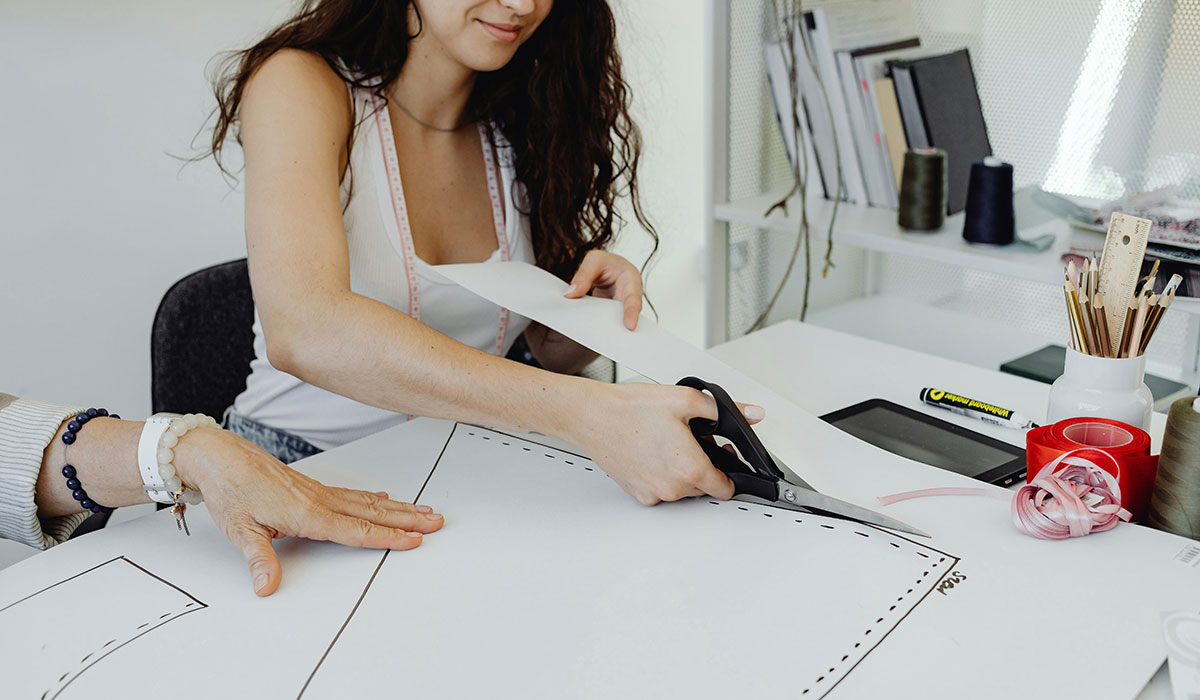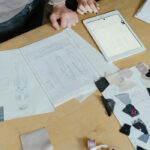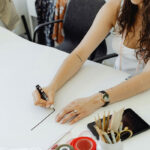Introduction
In the exciting realm of sewing, patterns are indispensable allies for anyone looking to craft flawless garments. For those just starting out, mastering the art of sewing patterns can drastically reduce time and effort while yielding outstanding results in your projects. This guide will take you through every aspect of using a sewing pattern—from grasping the various types available to the steps of cutting, stitching, and finishing your creation. By the conclusion of this article, you’ll possess both the knowledge and confidence needed to dive into your sewing adventures with enthusiasm!
Part 1: Getting to Know Sewing Patterns
What Exactly is a Sewing Pattern?
A sewing pattern acts as a blueprint for shaping and constructing garments. These templates can be found in printed form or created digitally, encompassing all essential details required for cutting and stitching fabric to achieve your desired fit and style. Sewing patterns empower users to produce clothing with remarkable accuracy, eliminating guesswork in measurements and cuts. They serve as foundational guides for crafting a wide array of apparel—from everyday outfits to elegant formal wear.
A Quick Look Back at Sewing Patterns’ History
Sewing patterns have a rich history that spans centuries, undergoing substantial changes along the way. With improvements in printing technology during the 19th century, sewing patterns became more readily available than ever before. The first commercial patterns emerged in the early 1800s, enabling seamstresses and tailors to create garments with enhanced precision and speed. Nowadays, thanks to modern technology, these invaluable tools are easily accessible—not only on paper but also through downloads from websites and mobile applications.
Part 2: Exploring Different Types of Sewing Patterns
Patterns Categorized by Size
Each sewing pattern is offered in multiple sizes typically labeled as XS, S, M, L, XL, or XXL. To choose the right pattern for yourself or someone else, it’s crucial to know accurate body measurements and compare them against the size chart included with each pattern. Remember that sizing may differ across brands; always consult the specific size chart that accompanies your chosen pattern!
Patterns Tailored for Various Garments
There’s an extensive selection of sewing patterns designed based on garment type! Here are some popular categories:
- Shirt Patterns: Covering styles like t-shirts, blouses, and button-down shirts—each featuring unique design elements such as collars or sleeves.
- Pants Patterns: Ranging from jeans and trousers to shorts and skirts—these allow for diverse styles from relaxed fits to tailored looks.
- Dress Patterns: Whether it’s casual dresses or elegant evening gowns—each style has dedicated patterns suited for different fabrics and occasions.
- Lingerie Patterns: Specializing in items like bras or sleepwear—these often require delicate materials along with specific techniques reflected in their unique designs.
Patterns for Different Skill Levels
Sewing patterns are also designed for different skill levels:
- Simple Patterns: Suitable for beginners, these patterns typically have fewer details and are easier to work with. They often include straightforward instructions and require minimal sewing techniques.
- Complex Patterns: Aimed at experienced sewists, these patterns often include more intricate details, multiple pieces, and require higher sewing skills. They may involve techniques such as darts, pleats, or zippers, which can be challenging for beginners.
Part 3: Preparing to Use a Sewing Pattern
Essential Tools
To effectively use a sewing pattern, you’ll need to gather some basic tools, including:
- Scissors: For cutting fabric and patterns. It’s best to use fabric scissors that are sharp and specifically designated for fabric to ensure clean cuts.
- Fabric Marking Tools: To mark on fabric, such as tailor’s chalk, fabric pens, or water-soluble markers. These tools help you make accurate markings that can be easily removed later.
- Measuring Tape: For accurate measurements of your body and fabric. A flexible measuring tape is ideal for taking body measurements, while a ruler can help with straight cuts.
- Sewing Machine: If you want to sew your final product. Familiarize yourself with its features and functions to make the sewing process smoother.
- Needles and Thread: For sewing and finishing small details. Ensure you have the right type of needle for your fabric and thread that matches or complements your fabric color.
Choosing Fabric
The type of fabric you choose plays a crucial role in the quality of your final product. When selecting fabric, consider the following factors:
- Type of Fabric: Choose between cotton, linen, polyester, knit fabric, or specialty fabrics. Each type has its characteristics and is suited for different garments.
- Thickness: The thickness of the fabric will affect the garment’s structure and sewing process. Lighter fabrics may require different handling than heavier ones.
- Color and Pattern: Choose colors and patterns that match the garment style and your personal taste. Consider the fabric’s drape and how it will influence the final look of the garment.
Cutting the Pattern
Cutting the pattern accurately is essential to ensure that the garment pieces fit together properly. Here are some basic steps to follow when cutting your pattern:
- Lay the Pattern on the Fabric: Arrange the pattern pieces to optimize fabric usage. Pay attention to the grainline marked on the pattern, as this affects how the fabric hangs and stretches.
- Mark the Fabric: Use a fabric marking tool to trace cutting lines and necessary points on the fabric. Make sure to include notches and markings indicated on the pattern for matching seams.
- Cut the Fabric: Use scissors to cut along the marked lines, ensuring precision. Take your time and avoid rushing, as accuracy at this stage will lead to a better-fitting garment.
Part 4: Mastering the Art of Using a Sewing Pattern
Step 1: Dive into the Instructions!
Before you even think about picking up your needle and thread, take a moment to thoroughly examine the instructions included with your sewing pattern. These guidelines are packed with essential information, including how to properly use the pattern, decipher its symbols, and understand cutting techniques. Getting acquainted with these details will pave the way for a smoother garment-making experience! Look out for symbols like:
- Sewing Lines: These indicate where you should stitch.
- Cutting Lines: Follow these when trimming your fabric.
- Notches: These points must align or be stitched together.
Step 2: Mark and Cut Your Fabric!
After soaking in those instructions, it’s time to mark and cut your fabric! Grab a measuring tape to ensure precision as you cut along the lines of the pattern—don’t rush through this step. Pay special attention to those sewing lines and notches; accuracy is key!
Step 3: Sew It All Together!
With your pieces cut out, it’s time for some stitching magic! Here’s a simple sequence to follow:
- Pin It Down: Securely pin your fabric pieces together before sewing; this will keep everything in place and prevent any shifting while you work.
- Start Sewing: Tackle simpler sections first—like collars or sleeves—before moving on to more intricate areas. Use a straight stitch for most seams, remembering to backstitch at both ends for extra durability.
- Check Your Work: Once everything is sewn up, inspect those seams for neatness and security. Give them a good press with an iron so that your garment looks professionally finished!
Part 5: Pro Tips & Reminders for Using Sewing Patterns
Time-Saving Strategies
- Plan Ahead: Take some time upfront to map out each step of your project—it’ll save you precious time later on! Create a timeline so you can track how you’re progressing.
- Utilize a Sewing Machine: If you’ve got one at hand, using a sewing machine can dramatically speed up your work process! Get familiar with its features so you can make the most of it.
Avoiding Common Pitfalls
- Double Check Measurements: Always confirm that both the pattern and fabric measurements are spot on before making any cuts—remember: measure twice, cut once!
- Get Acquainted with Your Pattern: Spend some time understanding all those symbols and instructions before diving in; this knowledge will make everything flow much more smoothly.
Practice Makes Perfect!
Don’t let initial setbacks discourage you—sewing is an art that requires practice! The more projects you tackle (even small ones or using scrap fabric), the more skilled you’ll become over time. Embrace each challenge as part of your creative journey!
Part 6: Extra Resources for Your Sewing Adventure
Books and Online Learning
To boost your sewing abilities, delve into a variety of books and online courses tailored to your needs. Here are some fantastic options to consider:
- Introductory Sewing Books: These beginner-friendly guides feature clear step-by-step instructions and helpful illustrations to make learning easy.
- Online Sewing Classes: Websites like Craftsy or Skillshare provide a wide range of courses focusing on different sewing techniques, pattern drafting, and garment creation.
Recommended Products on Amazon
Here’s a selection of great products available on Amazon that you might find helpful:
- Premium Fabric Scissors: Check it out on Amazon
- Essential Sewing Kit: Find it on Amazon
- Beginner’s Guide to Sewing: Available on Amazon
- User-Friendly Sewing Machine: Explore it on Amazon
- Fabric Marking Tools: View them on Amazon
Wrapping Up
Sewing patterns are invaluable resources that guide newcomers as they explore the sewing universe. This guide has equipped you with essential insights into selecting the right pattern, cutting, and assembling your project. Remember to take things at your own pace, hone your skills through practice, and don’t hesitate to seek out additional resources or community support as you embark on this exciting journey. Here’s to your success in all things creative—happy sewing!








